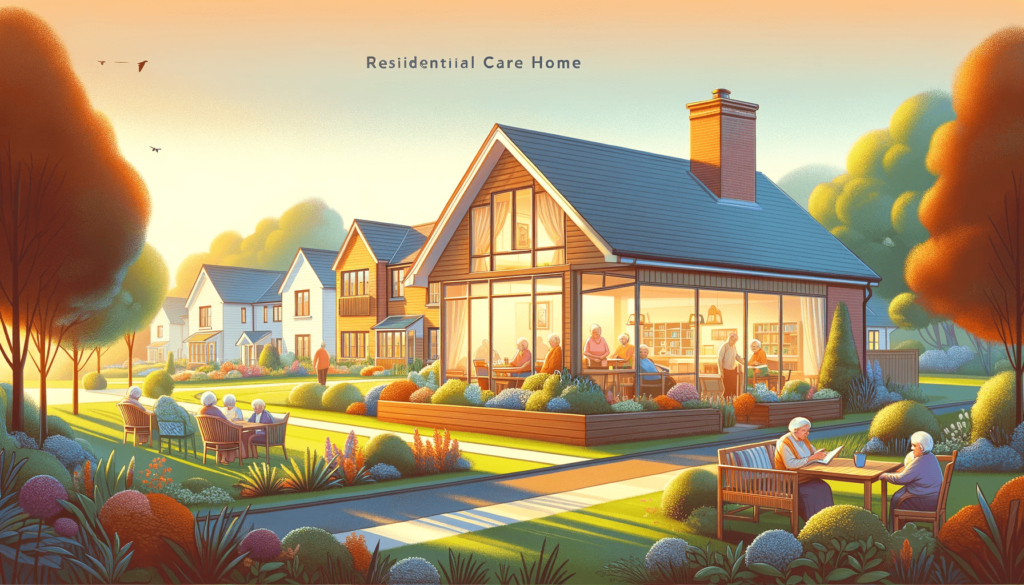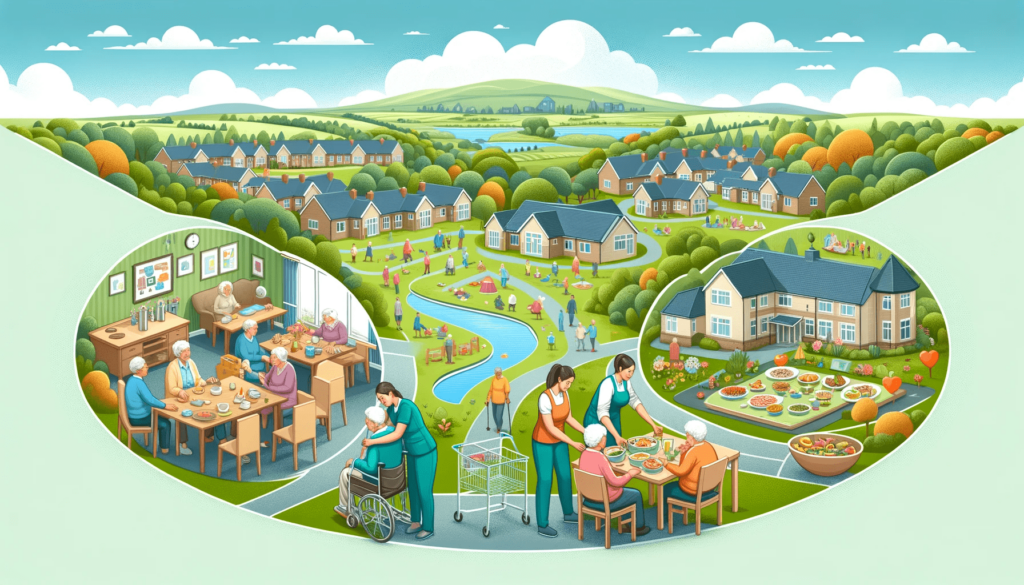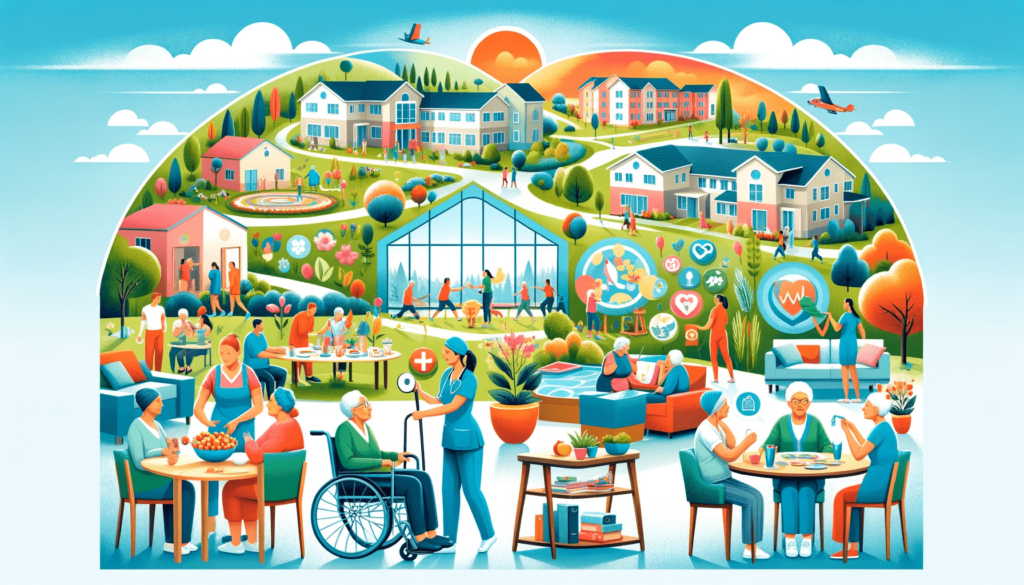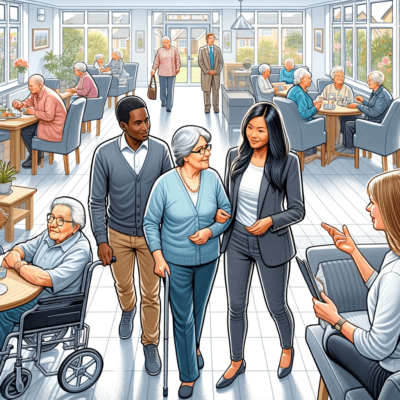Purpose of the Guide This guide is designed to serve as an essential resource for individuals and families in the United Kingdom navigating the complex world of care homes. The transition to a care home, whether for oneself or a…
ReadIntroduction to Residential Care Homes
Definition and Overview
Residential care homes provide a vital service for those who require assistance with daily living but do not need the intensive medical care provided by nursing homes. These facilities offer a combination of lodging, personal care services, and support, ensuring that residents live in a safe, comfortable, and caring environment. This type of care is particularly suited for the elderly, people with disabilities, or those who are no longer able to live independently due to various health reasons.
In a residential care home, residents receive help with everyday tasks such as bathing, dressing, medication management, and meal preparation. The emphasis is on providing a home-like atmosphere where residents can enjoy a degree of independence, with the reassurance that help is at hand when needed.
Distinction from Other Types of Care Homes
Residential care homes differ from other types of care facilities in several ways:
- Level of Medical Care: Unlike nursing homes, residential care homes typically do not provide intensive medical care or have medical staff like registered nurses on-site 24/7. The focus is more on personal care and support.
- Independence: Residents in residential care homes usually have more independence compared to those in nursing homes. They are often more mobile and engage more actively in social activities.
- Facility Size: Residential care homes tend to be smaller and more intimate compared to larger nursing homes, fostering a more personal and homely environment.
For an in-depth look into the various aspects of care homes, you can refer to our comprehensive care home guide, which covers all types of care homes, their services, and how to choose the best option for your needs.
This introduction sets the stage for a deeper exploration of residential care homes, understanding their role in providing essential care while promoting independence and quality of life for their residents.

Who Are Residential Care Homes For?
Ideal Candidates for Residential Care
Residential care homes cater to a variety of individuals, primarily focusing on those who need assistance with daily activities but do not require intensive medical care. The ideal candidates for such care settings include:
- Elderly Individuals: Particularly those who find independent living challenging due to age-related difficulties.
- People with Mobility Issues: Individuals who require help with mobility but do not need constant medical supervision.
- Those with Mild Cognitive Impairments: Such as early stages of dementia, where intensive nursing care isn’t necessary yet.
- Individuals Seeking Community and Social Interaction: For those looking for companionship, social activities, and a community environment to prevent loneliness and isolation.
Common Reasons for Choosing Residential Care
Several factors influence the decision to choose residential care:
- Safety and Security: These homes offer a secure environment, with staff available to address emergencies and provide constant support.
- Personal Care Assistance: Assistance is available for daily tasks such as bathing, dressing, and managing medication.
- Social Engagement: Opportunities abound for residents to engage in social activities, events, and community living, enhancing their quality of life.
- Relief for Family Caregivers: Residential care homes present a professional and compassionate care option for families who find it challenging to provide all the necessary care themselves.
- Structured Environment: They provide a predictable and stable daily routine, offering comfort and stability, which is especially important for individuals with cognitive challenges.
Residential care homes thus offer a blend of support, care, and community, making them an ideal choice for many looking for an alternative to independent living or more intensive nursing care.
Types of Residential Care Homes
Standard Residential Care
Standard residential care homes provide a fundamental level of care and support, catering primarily to individuals who do not require intensive medical or nursing care. These facilities typically offer:
- Personal Care Services: Assistance with daily activities such as bathing, dressing, eating, and medication management.
- Social Activities: A range of group activities, workshops, and social events to encourage community living and social interaction.
- Basic Healthcare Monitoring: Although not providing intensive medical care, these homes monitor the general health and well-being of residents.
- Meals and Nutrition: Provision of meals, including catering to specific dietary requirements and preferences.
- Housekeeping and Maintenance: Ensuring residents live in a clean, safe, and well-maintained environment.
Specialist Residential Care (e.g., for Dementia)
Specialist residential care homes cater to specific needs, such as those of individuals with dementia. These homes are tailored to provide:
- Specialised Care for Dementia Patients: Focused care and support for individuals with dementia, including tailored activities and therapies.
- Enhanced Safety Features: Adaptations to the living environment to ensure safety and ease of navigation for residents with cognitive impairments.
- Trained Staff: Staff specially trained in dementia care, equipped to handle the unique challenges and needs of these residents.
- Therapeutic Activities: Activities designed to support cognitive function, memory, and overall well-being, suitable for individuals with dementia.
- Family Support and Education: Providing families with resources and education about dementia and how to support their loved ones effectively.
Both standard and specialist residential care homes play a crucial role in providing supportive living environments. The choice between the two depends on the specific care needs and medical conditions of the individual. For a broader understanding of the different types of care homes and their services, you can refer to our main guide at /care-home-guide/.
Services Offered in Residential Care Homes
Personal Care Services
Personal care is a cornerstone of services offered in residential care homes, ensuring residents receive the support they need with daily activities. These services typically include:
- Assistance with Daily Living: Help with bathing, dressing, grooming, and toileting.
- Medication Management: Ensuring residents take their medications correctly and on time.
- Mobility Assistance: Aid with walking, transferring, and preventing falls.
- Personal Hygiene Maintenance: Support with tasks like brushing teeth and hair care.
Social and Recreational Activities
Social and recreational activities are crucial for the emotional and mental well-being of residents. Residential care homes offer a variety of activities, such as:
- Group Activities: Crafts, games, music, and other group activities to encourage socialisation and fun.
- Exercise and Fitness Programs: Tailored exercise sessions to maintain physical health and mobility.
- Cultural and Educational Events: Organising outings, guest speakers, and educational programs.
- Hobby and Interest Groups: Facilitating hobby groups based on residents’ interests, like gardening, book clubs, or knitting.
Meal Provision and Nutrition
Nutrition is an essential aspect of care in residential homes, with services including:
- Balanced Meals: Providing well-balanced, nutritious meals that cater to the dietary needs and preferences of residents.
- Special Diets: Accommodating special dietary requirements, whether for health, cultural, or personal reasons.
- Dining Experience: Creating a pleasant dining atmosphere where residents can enjoy meals socially.
- Snacks and Hydration: Ensuring residents have access to snacks and drinks throughout the day to stay hydrated and nourished.
These services collectively contribute to a high quality of life in residential care homes, ensuring that residents’ physical, social, and nutritional needs are met in a caring and supportive environment.

Choosing the Right Residential Care Home
Location Considerations
Choosing the right location for a residential care home is crucial for both the resident’s well-being and ease of family visits. Factors to consider include:
- Proximity to Family and Friends: A location that is easily accessible for regular visits can help maintain strong family connections.
- Community Accessibility: The convenience of nearby amenities such as shops, parks, and medical facilities.
- Environment and Setting: Whether a quiet, rural setting or a more urban environment is preferred for the resident’s comfort and happiness.
Assessing Quality and Standards
The quality and standards of a residential care home are paramount. When assessing these, consider:
- Accreditation and Ratings: Check for accreditations and inspect any available inspection reports from regulatory bodies.
- Staff Qualifications and Training: Inquire about the training and background of the staff, including care providers and management.
- Resident Satisfaction: Speak to current residents and their families about their experiences and level of satisfaction with the care provided.
- Policies and Procedures: Review the home’s policies on care, emergencies, and resident rights to ensure they align with your expectations.
Visiting and Evaluating Potential Homes
Visiting potential homes is a critical step in the selection process:
- First Impressions: Note your initial feelings about the cleanliness, atmosphere, and attitude of staff.
- Interaction Observation: Observe how staff interact with residents and how residents seem to feel and behave in the home.
- Facilities and Services: Tour the entire facility, checking for amenities like common areas, outdoor spaces, and special care facilities.
- Meal Quality: Consider dining in at the facility to experience the food quality and service first-hand.
Choosing the right residential care home involves careful consideration of these factors to ensure the best fit for the resident’s needs and preferences. For more detailed information on different types of care homes, you can refer back to our main guide at /care-home-guide/.
Understanding Costs and Funding
Cost Structure for Residential Care Homes
Understanding the cost structure of residential care homes is essential for financial planning. These costs typically include:
- Basic Accommodation Costs: Charges for room and board, which may vary based on room size and amenities.
- Care Service Fees: Costs for personal care services provided within the home.
- Additional Expenses: Fees for extra services like special activities, hairdressing, or private therapies.
Financial Assistance and Funding Options
Several options may be available to help manage the costs of residential care:
- Local Authority Funding: If eligible, the local council may contribute towards the cost of care.
- NHS Funding: In certain circumstances, the NHS may cover some care costs.
- Benefits and Allowances: Check eligibility for benefits like Pension Credit or Attendance Allowance.
Planning and Budgeting Tips
Effective financial planning can help manage the costs of care:
- Long-Term Planning: Consider future care needs and the potential for cost increases over time.
- Seek Professional Advice: Financial advisors specialising in elder care can provide valuable insights and planning strategies.
The Admission Process
Initial Assessment and Care Planning
Before admission, a care assessment is conducted to determine the individual’s specific needs. This process involves:
- Health and Care Needs Assessment: Evaluating the medical, physical, and emotional needs of the prospective resident.
- Care Plan Development: Creating a personalised care plan tailored to the individual’s specific requirements.
What to Expect During the Transition
Transitioning to a care home is a significant change:
- Adjustment Period: Understand that it may take time for the new resident to adjust to their new environment.
- Communication with Staff: Regular communication with care home staff can help ease the transition.
Tips for a Smooth Move-In
A well-planned move can make the transition smoother:
- Personalising the Space: Bring personal items to make the new space feel like home.
- Familiarisation Visits: Visit the care home a few times before moving in to become familiar with the environment and staff.
- Family Involvement: Having family members involved in the move can provide comfort and support.
Understanding these aspects of the admission process can help ensure a more comfortable and less stressful transition to residential care.

Daily Life in a Residential Care Home
Typical Daily Schedule
A typical day in a residential care home is structured to provide a balance of activities and rest. Common elements include:
- Morning Routine: Assistance with personal care, followed by breakfast.
- Scheduled Activities: Organised events or activities throughout the day, such as exercise classes, art sessions, or gardening.
- Meal Times: Regularly scheduled meals, often in a communal dining area.
- Free Time: Opportunities for residents to pursue personal hobbies or relax.
- Evening Routine: Dinner followed by leisure activities before bedtime.
Community and Social Life
Residential care homes place great emphasis on fostering a sense of community and encouraging social interaction:
- Group Activities: Facilitating social events and group activities for residents to interact and engage with each other.
- Celebrations and Events: Organising special events for holidays, birthdays, and cultural celebrations.
- Community Involvement: Opportunities for residents to engage with the local community through outings or inviting community members to the home.
Resident Autonomy and Personal Space
Respecting each resident’s autonomy and personal space is key:
- Individual Choices: Allowing residents to make choices about their daily activities, meals, and routines.
- Privacy: Ensuring residents have private spaces and times where they can be alone or with chosen company.
- Personalisation: Encouraging residents to personalise their living spaces with personal belongings and decorations.
Health and Wellness in Residential Care
Health Monitoring and Medical Support
Continuous health monitoring is an integral part of residential care:
- Regular Check-Ups: Routine health assessments to monitor the well-being of residents.
- Medication Management: Ensuring residents receive and take their medications as prescribed.
- Liaison with Healthcare Providers: Coordinating with external healthcare providers for specialised medical needs.
Physical and Mental Well-being
Maintaining the physical and mental health of residents is a priority:
- Exercise and Fitness: Tailored physical activities to suit the abilities and needs of residents.
- Mental Health Support: Providing access to mental health resources like counseling or therapy.
- Social Interaction: Encouraging participation in social activities to promote mental and emotional well-being.
Accessibility and Mobility Support
Adaptations and support for those with mobility issues:
- Mobility Aids: Provision of aids like walkers, wheelchairs, and handrails.
- Accessible Facilities: Ensuring the care home is equipped with ramps, lifts, and other features to aid mobility.
- Personal Assistance: Providing assistance to those who need help with moving around the home.
Daily life in a residential care home is about creating a supportive, engaging, and healthy environment where residents can enjoy a good quality of life while receiving the care they need.

Family Roles and Communication
Keeping in Touch with Residents
Maintaining communication between residents and their families is essential for emotional well-being and continued family bonds. Residential care homes facilitate this through:
- Regular Updates: Providing families with updates on the resident’s well-being and activities.
- Technology Use: Utilising technology like video calls, emails, and social media to stay connected.
- Mail and Packages: Encouraging families to send letters, photos, and care packages to residents.
Family Visits and Involvement
Visits from family members are a vital part of life in a residential care home:
- Flexible Visiting Hours: Accommodating families’ schedules to facilitate regular visits.
- Participation in Activities: Families are often welcomed to join in activities and events.
- Family Meetings: Regularly scheduled meetings to discuss care plans and any concerns.
Navigating Difficult Conversations
Sometimes families need to engage in challenging discussions about care, changes in health status, or end-of-life planning. Tips for navigating these include:
- Open and Honest Communication: Encouraging frank and compassionate conversations.
- Professional Guidance: Seeking advice from care home staff or professional counselors.
- Supportive Environment: Choosing a private and comfortable setting for these discussions.
Safety, Security, and Resident Rights
Safety Protocols and Emergency Procedures
Ensuring the safety and security of residents is paramount in residential care homes. This includes:
- Regular Safety Drills: Conducting fire and emergency drills to ensure preparedness.
- Security Measures: Implementing security protocols like secure entry systems and surveillance.
- Health and Safety Compliance: Adhering to health and safety regulations to prevent accidents.
Upholding Residents’ Rights and Privacy
Residential care homes are committed to protecting the rights and privacy of their residents:
- Respect for Individuality: Treating each resident with dignity and respect.
- Confidentiality: Maintaining the confidentiality of residents’ personal and medical information.
- Personal Choice: Supporting residents’ right to make choices about their care and daily life.
Complaints and Grievances Handling
A transparent and responsive approach to handling complaints and grievances is essential:
- Clear Complaint Procedures: Providing easily accessible information on how to raise concerns or complaints.
- Prompt Responses: Ensuring timely and appropriate responses to grievances.
- Continuous Improvement: Using feedback to improve care and services continually.
These aspects of family roles, communication, safety, security, and resident rights are crucial in providing a supportive, respectful, and safe environment for residents in residential care homes.
Long-Term Considerations
Planning for Changing Care Needs
As residents age or their health status changes, their care needs might also evolve. It’s important to plan for these changes:
- Regular Assessments: Ensuring ongoing assessments to monitor changes in health and care needs.
- Flexible Care Plans: Developing care plans that can adapt to changing needs, whether for more personal care or specialised medical attention.
- Communication with Families: Keeping open lines of communication with family members about changes in care needs and options.
End-of-Life Care Options and Support
End-of-life care is a sensitive and crucial aspect of long-term care planning:
- Palliative Care Services: Providing comfort and support to residents who are in the end stages of life.
- Family Support and Counseling: Offering counseling and support services to families during this challenging time.
- Advanced Care Planning: Encouraging discussions and documentation about end-of-life wishes and care preferences.
Conclusion and Next Steps
Summarising Key Takeaways
This guide has covered the essential aspects of residential care homes, from understanding the types of care and services provided to evaluating and choosing the right home. Key takeaways include the importance of personalised care, the need for active family involvement, and the significance of planning for long-term needs.
How to Proceed with Choosing a Residential Care Home
To proceed with choosing a residential care home:
- Assess Personal and Medical Needs: Consider the current and future health and personal care needs of the potential resident.
- Visit Multiple Homes: Tour various homes to compare services, environments, and cultures.
- Consult with Professionals: Seek advice from healthcare professionals, financial advisors, and care home staff.
- Involve the Family: Make sure to involve family members in the decision-making process.




